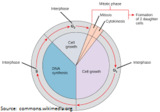
Students will create a 360-degree, interactive tour of the cell cycle.
- Subject:
- Biology
- Material Type:
- Assessment
- Author:
- Michelle Adams
- Date Added:
- 03/04/2020

Students will create a 360-degree, interactive tour of the cell cycle.

This resource is a video abstract of a research paper created by Research Square on behalf of its authors. It provides a synopsis that's easy to understand, and can be used to introduce the topics it covers to students, researchers, and the general public. The video's transcript is also provided in full, with a portion provided below for preview:
"Critical defects that compromise the nucleus during cell division could be the basis for the age-accelerating effects of people living with progeria. Hutchinson-Gilford progeria syndrome is a genetic disorder that causes premature aging. Affecting one in 8 million newborns worldwide, the disorder is extremely rare—and fatal. The rapid aging of the cardiovascular system causes death due to heart attack or stroke in patients by their mid-teens. Progeria is caused by a tiny point mutation in the lamin A gene. This gene is responsible for producing structural proteins called lamins, which form the scaffolding that holds the cell nucleus together. The mutated form of prelamin A called progerin destabilizes the cell nucleus—the genetic control center of cells. The result is the fast-aging effects observed in progeria. But the link from gene mutation to physical disorder has remained a mystery. Previous studies have looked only at models of progeria, not at actual patient cells..."
The rest of the transcript, along with a link to the research itself, is available on the resource itself.

In this unit, students look at the components of cells and their functions and discover the controversy behind stem cell research. The first lesson focuses on the difference between prokaryotic and eukaryotic cells. In the second lesson, students learn about the basics of cellular respiration. They also learn about the application of cellular respiration to engineering and bioremediation. The third lesson continues students' education on cells in the human body and how (and why) engineers are involved in the research of stem cell behavior.

Life as an emergent property of networks of chemical reactions involving proteins and nucleic acids. Mathematical theories of metabolism, gene regulation, signal transduction, chemotaxis, excitability, motility, mitosis, development, and immunity. Applications to directed molecular evolution, DNA computing, and metabolic and genetic engineering.

Comparison of the processes of mitosis and meiosis. Mitosis produces two diploid (2n) somatic cells that are genetically identical to each other and the original parent cell, whereas meiosis produces four haploid (n) gametes that are genetically unique from each other and the original parent (germ) cell. Mitosis involves one cell division, whereas meiosis involves two cell divisions.
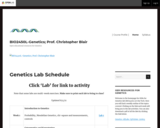
This site is an OER lab manual for a college level genetics course.
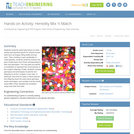
Students randomly select jelly beans (or other candy) that represent genes for several human traits such as tongue-rolling ability and eye color. Then, working in pairs (preferably of mixed gender), students randomly choose new pairs of jelly beans from those corresponding to their own genotypes. The new pairs are placed on toothpicks to represent the chromosomes of the couple's offspring. Finally, students compare genotypes and phenotypes of parents and offspring for all the "couples" in the class. In particular, they look to see if there are cases where parents and offspring share the exact same genotype and/or phenotype, and consider how the results would differ if they repeated the simulation using more than four traits.
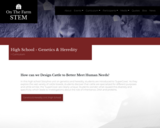
How can we Design Cattle to Better Meet Human Needs?
In this high school Storyline unit on genetics and heredity, students are introduced to ‘SuperCows’. As they explore the vast variety of cattle breeds, students discover that cattle are specialized for different purposes and while similar, the ‘SuperCows’ are clearly unique. Students wonder what caused this diversity and specificity which leads to investigations about the role of inheritance, DNA and proteins.
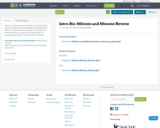
This is a review exercise on mitosis and meiosis. Many students struggle with recognizing the similarities and differences between these processes. Therefore, this exercise involves a compare and contrast table. A concept map is used to review the steps of meiosis.

This is a laboratory manual designed for an Introductory Biology Course. Topics covered include Data and Literature, Basic Scientific Skills, the Scientific Method, Macromolecules, Diffiusion and Osmosis, Enzymes, Microscopes and Cells, Cellular Respiration and Photosynthesis, The Cell Cycle, Mitosis and Meiosis, Genetics and DNA Fingerprinting. Each lab has a pre-laboratory assignment and post-laboratory assignment for students to complete. Additional resources referenced in the lab are provided, as well as grading rubrics for every assignment and a Lab Instructor Manual that contains lab notes and results from the lab exercises. A recipe list for all reagents is also included.

This resource is a video abstract of a research paper created by Research Square on behalf of its authors. It provides a synopsis that's easy to understand, and can be used to introduce the topics it covers to students, researchers, and the general public. The video's transcript is also provided in full, with a portion provided below for preview:
"In endocytosis, the cell plasma membrane folds inward and pinches off to form intracellular vesicles. Originally, endocytosis was thought to primarily facilitate feeding and pathogen neutralization, but it is now known to regulate numerous processes in eukaryotic cells, such as signaling, membrane composition, mitosis, movement, and morphogenesis. Endocytosis also plays many roles in T cells through both clathrin-dependent and clathrin-independent mechanisms. For example, clathrin-mediated endocytosis regulates the receptors on the plasma membrane and internalizes α/β-type T cell antigen receptors (TCRs). Through clathrin-independent pathways, endocytosis internalizes TCRζ and the IL-2Rβ complex and recycles TCRαβ. Clathrin-independent endocytosis also helps T cells bind to antigen-presenting cells of the immune system and ingest pathogens and other foreign materials to aid in host defense and immune surveillance..."
The rest of the transcript, along with a link to the research itself, is available on the resource itself.
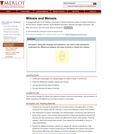
Drawings and animations, are used to help participants understand the differences between and steps involved in mitosis and meiosis. The cell cycle as well as individual steps of mitosis and meiosis are included in this learning material.
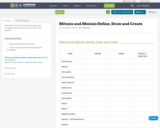
Understand mitosis and meiosis through term recognition, depiction and creation of an exam question.

The human body is composed of trillions of cells. Each cell has a specific purpose to help carry out life. Many of these trillions of cells will wear out and need replaced. This essential process for life is called mitosis. In this seminar you will explore, compare, and reflect on how cells reproduce and make copies of themselves. Additionally, you will be challenged to create a model of the process based on your experience.StandardsBIO.B.1.1.1 Describe the events that occur during the cell cycle: interphase, nuclear division (i.e., mitosis or meiosis), cytokinesis.
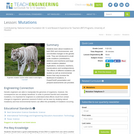
Students learn about mutations to both DNA and chromosomes, and uncontrolled changes to the genetic code. They are introduced to small-scale mutations (substitutions, deletions and insertions) and large-scale mutations (deletion duplications, inversions, insertions, translocations and nondisjunctions). The effects of different mutations are studied as well as environmental factors that may increase the likelihood of mutations. A PowerPoint® presentation and pre/post-assessments are provided.
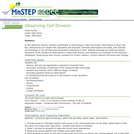
This is a classroom activity in which students observe and describe cells in stages of division. They share observations about what they see in the cells, then formulate questions and do research concerning the changes that take place in cells during the process.

Psychology is designed to meet scope and sequence requirements for the single-semester introduction to psychology course. The book offers a comprehensive treatment of core concepts, grounded in both classic studies and current and emerging research. The text also includes coverage of the DSM-5 in examinations of psychological disorders. Psychology incorporates discussions that reflect the diversity within the discipline, as well as the diversity of cultures and communities across the globe.Senior Contributing AuthorsRose M. Spielman, Formerly of Quinnipiac UniversityContributing AuthorsKathryn Dumper, Bainbridge State CollegeWilliam Jenkins, Mercer UniversityArlene Lacombe, Saint Joseph's UniversityMarilyn Lovett, Livingstone CollegeMarion Perlmutter, University of Michigan

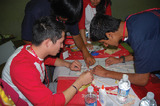
By the end of this section, you will be able to:Describe the stages of prenatal development and recognize the importance of prenatal careDiscuss physical, cognitive, and emotional development that occurs from infancy through childhoodDiscuss physical, cognitive, and emotional development that occurs during adolescenceDiscuss physical, cognitive, and emotional development that occurs in adulthood

This resource is a video abstract of a research paper created by Research Square on behalf of its authors. It provides a synopsis that's easy to understand, and can be used to introduce the topics it covers to students, researchers, and the general public. The video's transcript is also provided in full, with a portion provided below for preview:
"An international team of biologists has done the seemingly impossible. They’ve revived cell nuclei from a 28,000-year-old frozen woolly mammoth. While the world will have to wait for the first full-blown mammoth resurrection, this could be a big step in that direction. The team’s findings offer researchers hope that ancient DNA, though damaged, could one day be made functional. The research team salvaged the nuclei from the muscle of “Yuka,” a young woolly mammoth well preserved in Siberian permafrost since the last ice age. They then transplanted them into mouse egg cells. This process, called somatic cell nuclear transfer, is the same one used to clone animals like Dolly the sheep. But unlike for Dolly, the development of those nuclei stopped short of cell division. After the transfer, researchers observed filling of the transplanted nuclei with mouse proteins—namely, histone and tubulin— and the formation of a new nucleus-like structure..."
The rest of the transcript, along with a link to the research itself, is available on the resource itself.